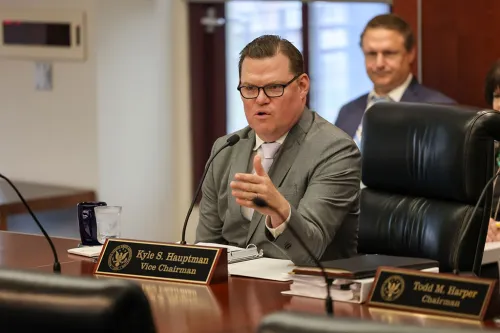NCUA Vice Chairman Kyle S. Hauptman at a meeting of the NCUA Board.
As Prepared for Delivery on July 18, 2024
In 1980, Congress passed the Monetary Control Act, which, among other things, raised the credit union interest rate ceiling to 15 percent from the statutory limit of 12 percent. Congress also granted the NCUA Board the discretion to increase the interest rate cap for safety and soundness reasons for periods not exceeding 18 months. But the only interest rate currently listed in the act is 15 percent.
Some might recall that the reason Congress acted in 1980, the Fed raised rates to unprecedented levels. Immediately after the Monetary Control Act passed, the Board used its discretion to raise the maximum rate to 21 percent, where it remained for a few years. At that time, the prime rate was 20.5 percent. This is the context I’m considering when trying to understand Congressional intent.
Three criteria must be met for the NCUA Board to maintain the current interest rate cap at 18 percent. As noted in the presentation, all three of the following criteria must be met:
- Consultation with Congress, the Treasury Department, and the Federal Financial Regulatory Agencies
- Money market interest rates have risen over the past 6 months, and
- Prevailing interest rates threaten the safety and soundness of individual credit unions.
If the Board does not act, the maximum rate reverts to the statutory maximum level of 15 percent. It’s worth noting again that the only rate specified in our current statute is 15 percent.
The last time we addressed the interest rate cap, the Board requested an analysis from the General Counsel’s Office on whether a variable rate would be legal. Although determined to be legal, there were issues with this approach – not the least of which was the potential for the interest rate cap to fall well below 15 percent if interest rates dropped. I don’t believe we at the NCUA could legally use a variable rate that was the Fed’s current overnight rate plus another 15–16 percent.
So, to everyone who objects to our current rate cap, I say: this is a matter for Congress. Once someone reads the actual law that we at the NCUA must follow, they arrive at the same conclusion — this is a matter for Congress, not the NCUA.
We’re only here today to do what Congress tells us to do regarding interest rates. We’re not here to decide what interest rate cap is ideal. I say this because many of the people who’ve argued for higher rates are not aware of what Congress has told the NCUA to do. Almost every time I ask someone, “well what interest policy would you implement if you were on the NCUA Board?” The answer is a policy that is illegal under federal law.
I’ll mention that I’m aware of the negative effects of government price-setting. But in this role today, I’m compelled to vote to maintain the current cap of 18 percent.
Currently, we do not have evidence that meets the criteria to raise the rate higher than 18 percent. At the same time, there are signals that lowering it would threaten the safety and soundness of individual credit unions.
The 18 percent ceiling provides low-income and CDFI credit unions necessary “head room” above the statutory rate of 15 percent. With inflation and the increasing cost of funds, these credit unions must make the hard choice of whether to serve their neediest members. For some low-income community and CDFI credit unions, this could be most of their membership.
One interesting data point is the dramatic uptick in Payday Alternative Loans (PALs), a higher-interest loan allowed by the NCUA. Despite the difficulty in offering PALs, 467 federal credit unions offer the program today, and by many measures, it is growing partly due to fintech providers that have finally made PALs feasible for credit unions.
The year-end outstanding balance of PALs doubled from $60 million in 2020 to $121 million in 2023. For the 18-month period ending in December 2023, the outstanding PALs balance grew by 44 percent, from $84 million to $121 million, with the active number of PALs increasing by 35 percent from 110,971 to 150,379. The total number and dollar amount of PALs granted year-to-date also more than doubled from 107,104 and $108 million to 256,591 and $271 million. As of December 31, 2023, nearly 40 percent of federal credit unions that offer PALs – 185 out of 467 – listed 28 percent as their most common interest rate for PALs on their year-end 2023 call reports.




